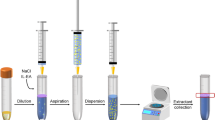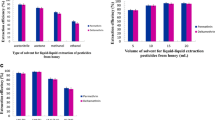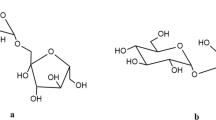Abstract
Based on the foaming property of the honey, a rapid, simple, and effective method solvent floatation (SF) was developed and firstly applied to the extraction and separation of triazine herbicides in honey. The analytes were determined by high-performance liquid chromatography. Some parameters affecting the extraction efficiencies, such as the type and volume of extraction solvent, type of salt, amount of (NH4)2SO4, pH value of sample solution, gas flow rate, and floatation time, were investigated and optimized. The limits of detection for analytes are in the range of 0.16–0.56 μg kg−1. The recoveries and relative standard deviations for determining triazines in five real honey samples are in the range of 78.2–112.9 and 0.2–9.2%, respectively.








Similar content being viewed by others
References
Li N, Jin H, Nian L, Wang Y, Lei L, Zhang R, et al. Pneumatic nebulization gas-solid extraction of triazine herbicides in vegetable. J Chromatogr A. 2013;1304:18–27.
Zhang K, Wong JW, Yang P, Tech K, Dibenedetto AL, Lee NS, et al. Multiresidue pesticide analysis of agricultural commodities using acetonitrile salt-out extraction, dispersive solid-phase sample clean-up, and high-performance liquid chromatography-tandem mass spectrometry. J Agric Food Chem. 2011;59:7636–46.
Nunez O, Gallart-Ayala H, Ferrer I, Moyano E, Galceran MT. Strategies for the multi-residue analysis of 100 pesticides by liquid chromatography-triple quadrupole mass spectrometry. J Chromatogr A. 2012;1249:164–80.
Orso D, Floriano L, Ribeiro LC, Bandeira NMG, Prestes OD, Zanella R. Simultaneous determination of multiclass pesticides and antibiotics in honey samples based on ultra-high performance liquid chromatography-tandem mass spectrometry. Food Anal Methods. 2015;9:1638–53.
He J, Song L, Chen S, Li Y, Wei H, Zhao D, et al. Novel restricted access materials combined to molecularly imprinted polymers for selective solid-phase extraction of organophosphorus pesticides from honey. Food Chem. 2015;187:331–7.
Tette PA, Rocha Guidi L, Gloria MB, Fernandes C. Pesticides in honey: a review on chromatographic analytical methods. Talanta. 2016;149:124–41.
Barcelo D. Occurrence, handling and chromatographic determination of pesticides in the aquatic environment. Rev Analyst. 1991;116:681–9.
Wang Y, Sun Y, Xu B, Li X, Jin R, Zhang H, et al. Magnetic ionic liquid-based dispersive liquid-liquid microextraction for the determination of triazine herbicides in vegetable oils by liquid chromatography. J Chromatogr A. 2014;1373:9–16.
Yue M-E, Li Q, Xu J, Jiang T-F. Salt de-emulsification dispersive liquid-liquid microextraction and back-extraction combined with sweeping micellar electrokinetic capillary chromatography for detection of triazine herbicides in honey. Food Anal Methods. 2016;9:699–705.
Zhu SH, Wu HL, Li BR, Xia AL, Han QJ, Zhang Y, et al. Determination of pesticides in honey using excitation-emission matrix fluorescence coupled with second-order calibration and second-order standard addition methods. Anal Chim Acta. 2008;619:165–72.
Fernandez M, Pico Y, Girotti S, Manes J. Analysis of organophosphorus pesticides in honeybee by liquid chromatography-atmospheric pressure chemical ionization-mass spectrometry. J Agric Food Chem. 2001;49:3540–7.
Garcia-Chao M, Agruna MJ, Flores Calvete G, Sakkas V, Llompart M, Dagnac T. Validation of an off line solid phase extraction liquid chromatography-tandem mass spectrometry method for the determination of systemic insecticide residues in honey and pollen samples collected in apiaries from NW Spain. Anal Chim Acta. 2010;672:107–13.
Tsipi D, Triantafyllou M, Hiskia A. Determination of organochlorine pesticide residues in honey, applying solid phase extraction with RP-C18 material. Analyst. 1999;124:473–5.
Korta E, Bakkali A, Berrueta LA, Gallo B, Vicente F. Study of semi-automated solid-phase extraction for the determination of acaricide residues in honey by liquid chromatography. J Chromatogr A. 2001;930:21–9.
Albero B, Sanchez-Brunete C, Tadeo JL. Analysis of pesticides in honey by solid-phase extraction and gas chromatography-mass spectrometry. J Agric Food Chem. 2004;52:5828–35.
Herrera A, Perez-Arquillue C, Conchello P, Bayarri S, Lazaro R, Yague C, et al. Determination of pesticides and PCBs in honey by solid-phase extraction cleanup followed by gas chromatography with electron-capture and nitrogen-phosphorus detection. Anal Bioanal Chem. 2005;381:695–701.
Zali S, Jalali F, Es-Haghi A, Shamsipur M. Electrospun nanostructured polystyrene as a new coating material for solid-phase microextraction: application to separation of multipesticides from honey samples. J Chromatogr B Analyt Technol Biomed Life Sci. 2015;1002:387–93.
Jimenez JJ, Bernal JL, MJd N, Martın MT, Mayorga AL. Solid-phase microextraction applied to the analysis of pesticide residues in honey using gas chromatography with electron-capture detection. J Chromatogr A. 1998;829:269–77.
Yu J, Wu C, Xing J. Development of new solid-phase microextraction fibers by sol–gel technology for the determination of organophosphorus pesticide multiresidues in food. J Chromatogr A. 2004;1036:101–11.
Farajzadeh MA, Mogaddam MR, Ghorbanpour H. Development of a new microextraction method based on elevated temperature dispersive liquid-liquid microextraction for determination of triazole pesticides residues in honey by gas chromatography-nitrogen phosphorus detection. J Chromatogr A. 2014;1347:8–16.
Zacharis CK, Rotsias I, Zachariadis PG, Zotos A. Dispersive liquid-liquid microextraction for the determination of organochlorine pesticides residues in honey by gas chromatography-electron capture and ion trap mass spectrometric detection. Food Chem. 2012;134:1665–72.
Wang Y, You J, Ren R, Xiao Y, Gao S, Zhang H, et al. Determination of triazines in honey by dispersive liquid-liquid microextraction high-performance liquid chromatography. J Chromatogr A. 2010;1217:4241–6.
Yu C, Hu B. Sol-gel polydimethylsiloxane/poly(vinylalcohol)-coated stir bar sorptive extraction of organophosphorus pesticides in honey and their determination by large volume injection GC. J Sep Sci. 2009;32:147–53.
Wu L, Song Y, Hu M, Yu C, Zhang H, Yu A, et al. Ionic-liquid-impregnated resin for the microwave-assisted solid-liquid extraction of triazine herbicides in honey. J Sep Sci. 2015;38:2953–9.
Proietto Galeano M, Scordino M, Sabatino L, Panto V, Morabito G, Chiappara E, et al. UHPLC/MS-MS analysis of six neonicotinoids in honey by modified QuEChERS: method development, validation, and uncertainty measurement. Int J Food Sci. 2013;2013:863904.
Malhat FM, Haggag MN, Loutfy NM, Osman MA, Ahmed MT. Residues of organochlorine and synthetic pyrethroid pesticides in honey, an indicator of ambient environment, a pilot study. Chemosphere. 2015;120:457–61.
Sebba F. Ion flotation. New York: Elsevier; 1962.
Han J, Wang Y, Yu C, Li C, Yan Y, Liu Y, et al. Separation, concentration and determination of chloramphenicol in environment and food using an ionic liquid/salt aqueous two-phase flotation system coupled with high-performance liquid chromatography. Anal Chim Acta. 2011;685:138–45.
Chang L, Bi P, Li X, Wei Y. Study of solvent sublation for concentration of trace phthalate esters in plastic beverage packaging and analysis by gas chromatography-mass spectrometry. Food Chem. 2015;177:127–33.
Li N, Zhang R, Nian L, Ren R, Wang Y, Zhang H, et al. Extraction of eight triazine and phenylurea herbicides in yogurt by ionic liquid foaming-based solvent floatation. J Chromatogr A. 2012;1222:22–8.
Xi Y, Dong H. Application of solvent sublation for the determination of organophosphorous pesticides in vegetables by gas chromatography with a flame photometric detector. Anal Sci. 2007;23:295–8.
Wang K, Jiang J, Kang M, Li D, Zang S, Tian S, et al. Magnetical hollow fiber bar collection of extract in homogenous ionic liquid microextraction of triazine herbicides in water samples. Anal Bioanal Chem. 2017;409:2569–79.
Wang K, Li N, Lei L, Yang X, Wang Z, Li D, et al. Collection and separation of extract in dispersive liquid-liquid microextraction with hollow fiber. Anal Bioanal Chem. 2016;408:3359–67.
Author information
Authors and Affiliations
Corresponding author
Ethics declarations
Conflict of interest
The authors declare that they have no competing interests.
Electronic supplementary material
ESM 1
(PDF 655 kb)
Rights and permissions
About this article
Cite this article
Wang, K., Jiang, J., Lv, X. et al. Application of solvent floatation to separation and determination of triazine herbicides in honey by high-performance liquid chromatography. Anal Bioanal Chem 410, 2183–2192 (2018). https://doi.org/10.1007/s00216-018-0881-5
Received:
Revised:
Accepted:
Published:
Issue Date:
DOI: https://doi.org/10.1007/s00216-018-0881-5




